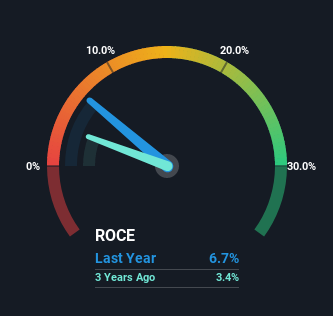Returns On Capital At Stamford Tyres (SGX:S29) Have Stalled
If we want to find a potential multi-bagger, often there are underlying trends that can provide clues. In a perfect world, we'd like to see a company investing more capital into its business and ideally the returns earned from that capital are also increasing. Ultimately, this demonstrates that it's a business that is reinvesting profits at increasing rates of return. Although, when we looked at Stamford Tyres (SGX:S29), it didn't seem to tick all of these boxes.
Understanding Return On Capital Employed (ROCE)
If you haven't worked with ROCE before, it measures the 'return' (pre-tax profit) a company generates from capital employed in its business. Analysts use this formula to calculate it for Stamford Tyres:
Return on Capital Employed = Earnings Before Interest and Tax (EBIT) ÷ (Total Assets - Current Liabilities)
0.067 = S$9.3m ÷ (S$241m - S$102m) (Based on the trailing twelve months to October 2022).
Thus, Stamford Tyres has an ROCE of 6.7%. On its own that's a low return, but compared to the average of 5.2% generated by the Retail Distributors industry, it's much better.
Check out our latest analysis for Stamford Tyres
Historical performance is a great place to start when researching a stock so above you can see the gauge for Stamford Tyres' ROCE against it's prior returns. If you're interested in investigating Stamford Tyres' past further, check out this free graph of past earnings, revenue and cash flow.
The Trend Of ROCE
Things have been pretty stable at Stamford Tyres, with its capital employed and returns on that capital staying somewhat the same for the last five years. This tells us the company isn't reinvesting in itself, so it's plausible that it's past the growth phase. So don't be surprised if Stamford Tyres doesn't end up being a multi-bagger in a few years time.
On a separate but related note, it's important to know that Stamford Tyres has a current liabilities to total assets ratio of 42%, which we'd consider pretty high. This effectively means that suppliers (or short-term creditors) are funding a large portion of the business, so just be aware that this can introduce some elements of risk. Ideally we'd like to see this reduce as that would mean fewer obligations bearing risks.
The Key Takeaway
We can conclude that in regards to Stamford Tyres' returns on capital employed and the trends, there isn't much change to report on. Since the stock has declined 18% over the last five years, investors may not be too optimistic on this trend improving either. On the whole, we aren't too inspired by the underlying trends and we think there may be better chances of finding a multi-bagger elsewhere.
On a final note, we found 4 warning signs for Stamford Tyres (2 are concerning) you should be aware of.
While Stamford Tyres may not currently earn the highest returns, we've compiled a list of companies that currently earn more than 25% return on equity. Check out this free list here.
Have feedback on this article? Concerned about the content? Get in touch with us directly. Alternatively, email editorial-team (at) simplywallst.com.
This article by Simply Wall St is general in nature. We provide commentary based on historical data and analyst forecasts only using an unbiased methodology and our articles are not intended to be financial advice. It does not constitute a recommendation to buy or sell any stock, and does not take account of your objectives, or your financial situation. We aim to bring you long-term focused analysis driven by fundamental data. Note that our analysis may not factor in the latest price-sensitive company announcements or qualitative material. Simply Wall St has no position in any stocks mentioned.
Join A Paid User Research Session
You’ll receive a US$30 Amazon Gift card for 1 hour of your time while helping us build better investing tools for the individual investors like yourself. Sign up here

